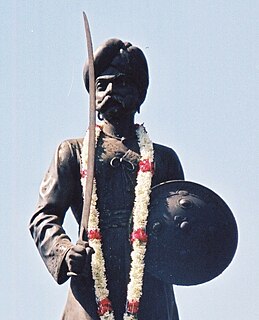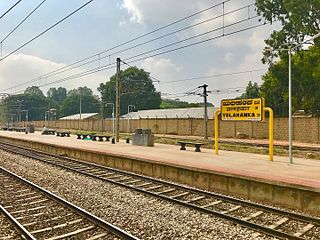
Sarang is the helicopter air display team of the Indian Air Force that flies four modified HAL Dhruv helicopters, also known as Advanced Light Helicopter (ALH). The team was formed in October 2003 and their first performance was at the Asian Aerospace show, Singapore, in 2004. The name Sarang is symbolic; the peacock is the national bird of India. The unit was inducted as No. 151 Helicopter Unit in 2005 and was shifted from Yelahanka AFS, Bangalore to Sulur AFS, Coimbatore in 2009.

Nadaprabhu Hiriya Kempe Gowda, also known as Kempe Gowda was a chieftain under the Vijayanagara Empire. The city of Bengaluru, capital of the Indian state of Karnataka, was fortified by Kempe Gowda in 1537. He erected many Kannada inscriptions in the Kannada Country.

Bangalore is the capital city of the state of Karnataka. Bangalore, as a city, was founded by Kempe Gowda I, who built a mud fort at the site in 1537. But the earliest evidence for the existence of a place called Bangalore dates back to c. 890.

Yelahanka is a suburb of Bangalore in the state of Karnataka and one of the zones of BBMP. It is older than the Bengaluru (Bangalore) city which has now overgrown engulfing many of its neighbouring villages and towns. It lies to the north of Bangalore City.

Basavanagudi is a residential and commercial locality in the Indian city of Bangalore. It is located in South Bangalore, along the borders of Jayanagar. The name "Basavanagudi" refers to the Bull Temple, which contains a monolith statue of the Nandi Bull. The word Basava in Kannada means bull, and gudi means temple.

Kolar is a city in the Indian state of Karnataka. It is the headquarters of Kolar district. The city is known for its milk production and the gold mines. It is also known for Someshwara temple and the Kolaramma temple.

Old Airport Road is a major road in Bangalore, India. It was renamed from Airport Road after the new Bengaluru International Airport was opened at Devanahalli. Madivala Machideva Road is a 17 km stretch road which begins from the junction of Trinity Church Road and Victoria Road and goes to HAL Bangalore International Airport, Marathahalli, Varthur. Beyond that, the road officially becomes Varthur Road, but since the real estate boom started around 2003, builders have started calling the stretch between the Airport and the Marathahalli Outer Ring Road as Old Airport Road. Even so, due to the high significance of this road it has achieved due to its high accessibility for reaching Whitefield.

Sri Sharadamba Temple is a famous Hindu temple dedicated to goddess Saraswati in the holy town of Sringeri in Karnataka, India.

Puttenahalli WS Lake also spelled as Puttanahalli Lake is a 10-hectare water body near Yelahanka, 14 km north of Bangalore.

The Ragigudda Sri Prasanna Anjaneya temple is a temple dedicated to Lord Hanuman, spread across 5 acres also having a hillock in Jayanagar 9th Block suburb of Bangalore,Karnataka, India. The temple also houses a Shivalinga along with Rama, Sita, Lakshmana, Hanuman shrine in the same precinct. The temple is on a hillock. There is a smaller temple dedicated to Ganesha, Navagraha and goddess Rajarajeshwari at the base of the hillock. It also plays host to the Hindu holy trinity of Brahma, Vishnu and Maheshwara on huge engraved rocks at the side of the temple.

Bangalore Fort began in 1537 as a mud fort. The builder was Kempe Gowda I, a vassal of the Vijaynagar Empire and the founder of Bangalore. Hyder Ali in 1761 replaced the mud fort with a stone fort and it was further improved by his son Tipu Sultan in the late 18th century. It was damaged during an Anglo-Mysore war in 1791. It still remains a good example of 18th-century military fortification. The army of the British East India Company, led by Lord Cornwallis on 21 March 1791 captured the fort in the siege of Bangalore during the Third Mysore War (1790–1792). At the time the fort was a stronghold for Tipu Sultan. Today, the fort's Delhi gate, on Krishnarajendra Road, and two bastions are the primary remains of the fort. A marble plaque commemorates the spot where the British breached fort's wall, leading to its capture. The old fort area also includes Tipu Sultan's Summer Palace, and his armoury. The fort has provided the setting for the treasure hunt in the book Riddle of the Seventh Stone.

Halasuru Someshwara Temple is located in the neighborhood of Halasuru in Bangalore, Karnataka,India. It is one of the old temples in the city dating back to the Chola period, it is dedicated to the Hindu god Shiva. Major additions or modifications were made during the late Vijayanagara Empire period under the rule of Hiriya Kempe Gowda II.

Bengaluru Pete is an area of Bangalore city which was established by Kempegowda I in 1537 with roads laid out in the cardinal directions, and entrance gates at the end of each road. Kempegowda also termed the Pete he built as his "gandu bhoomi" or "Land of Heroes". Pete forms a well–defined body of markets which were associated with various trades and professions of the populace in the locality markets and given the names of trades pursued in such markets. The well known markets are the Tharagupete–market for grains, the Balepete – for Bangles and musical instruments, the Chikkapete and the Nagarthpete for textile trade, the Ballapurpete and the Ganigarapete market where oil is extracted by people of the Ganiga community, the Tigalarapete–flower market of gardeners, the Cubbonpete – textile manufacture by people of the Devanga community.

Konetirayala Swamy Temple is a Hindu temple of Lord Venkateswara in the town of Keelapatla, Palamaner, Chittoor District, Andhra Pradesh, India.

Bangalore (Bengaluru), the capital of Karnataka state, India, reflects its multireligious and cosmopolitan character by its more than 1000 temples, 400 mosques, 100 churches, 40 Jain derasars, three Sikh gurdwaras, two Buddhist viharas and one Parsi fire temple located in an area of 741 km² of the metropolis. The religious places are further represented to include the few members of the Jewish community who are making their presence known through the Chabad that they propose to establish in Bengaluru and the fairly large number of the Baháʼí Faith whose presence is registered with a society called the Baháʼí Centre. In the demographically diverse, major economic hub and India's fastest-growing major metropolis of Bengaluru, the number of religious places of each religion reported reflects growth in proportion to the population growth. According to the 2001 census of India, 79.37% of Bangalore's population is Hindu, roughly the same as the national average. Muslims comprise 13.37% of the population, which again is roughly the same as the national average, while Christians and Jains account for 5.79% and 1.05% of the population, respectively, double that of their national averages. Anglo-Indians also form a substantial group within the city.

Yelahanka Lake, is a water body near Yelahanka, a suburb of Bangalore.

Muthathi is a settlement situated on the banks of the Kaveri river near Malavalli in the Indian state of Karnataka. It is surrounded by a dense forest which is the home of the Kaveri Wildlife Sanctuary. The location has mythological associations with Sita and Anjaneya, and there is a small temple dedicated to Anjaneya near the town. This well connected hilly place is accessible from Bangalore through direct bus/private vehicles.

The Anjaneya Temple at Nanganallur, Chennai is a Hindu temple dedicated to the god Hanuman. The principal idol of Hanuman is 32-feet tall and sculpted from a single piece of granite, which the second tallest Hanuman after Panchavatee near Puducherry.

Thindlu, once an ancient village, is now a part of the Bangalore North. Thindlu is famous for its ancient temple of lord Virabhadra and is currently a thriving community with many real estate constructions. Thindlu comes under Vidyaranyapura ward of Byatarayanapura constituency. Byatarayanapura is one of the largest constituency of Bangalore. Many residential layouts have recently come up. Thindlu is located to the east of Vidyaranyapura and to the west of Sahakara Nagar. Once a rural village, it has now become very well integrated to Bengaluru city style. With many new residential apartments and with the influx of people this area does not resemble anymore like an rural village, although some areas still retain Village type old houses. Although declining, Animal husbandry can still be witnessed here like any other part of Bangalore Rural district.

Yelahanka Junction railway station is an Indian Railways station in Bangalore in the Indian state of Karnataka, located in Yelahanka locality about 15 km away from the Bangalore City. It is one of the developing stations of Bangalore. This station is located on the Guntakal–Bangalore line.




















